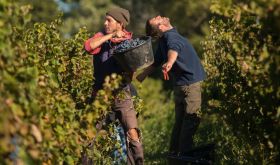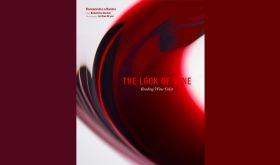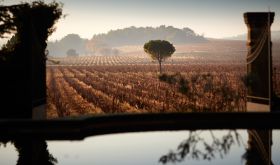No vintage has ever caught the imagination, dollars and pounds more than 2005. The result has been a scramble for allocations of all the finest wines of France, with Germany’s best being caught in the slipstream and the top Spanish 2005s being eagerly awaited. Italy and Austria were not so favoured in 2005, but that will not stop some of the less scrupulous merchants from trying to dust them with a little ’05 magic in their sales pitch.
But what effect does such a highly lauded year have on the vintages that precede and follow it? There have been pairs of vintages in which the later one has been overshadowed by acclaim for the earlier one – 1989 and 1990 for example – although this seems unlikely with 2005 and 2006. The 2006 summer weather pattern in Burgundy was, as Lalou Bize Leroy of Vosne-Romanée put it “épouvantable” [appalling]. She describes the resulting burgundies as “pretty”. Hardly a grandiose claim. Eric Rousseau at Domaine Armand Rousseau assured me that 2006 would definitely be better than 2004 as a vintage, even if there were strong similarities in the weather.
As for Bordeaux, I shall as usual be tasting the 2006 primeurs offerings in depth in early April and will report back but the Bordelais have been unusually quiet about this extremely testing vintage. Several respected Rhône producers meanwhile are already declaring themselves more than happy with their 2006s, but they are aware that 2006 will be a tough sell – for the same reason as the highly successful 2004 southern Rhônes have been underestimated. It is Bordeaux that sets the reputation of a vintage whatever the quality in other regions.
It is of course far too early to come up with definitive judgments on 2006s from a harvest that took place only a few months ago but I have recently been tasting a wide range of 2004s now that they are in bottle and thought that the results might be of interest, given the fact that in every region 2004s now look such bargains compared with the 2005s. As I reported here in November, the good news is that 2004 bordeaux look even better than they did en primeur, at least at classed growth level they do. (In stark contrast to 2005, 2004 bordeaux is not nearly so good lower down the ranks.)
There is not such good news as far as burgundy is concerned however. Given the huge demand for and relatively limited supply of 2005 burgundy, it would be delightful to report that it is not really necessary to pay through the nose for the 2005 and that the 2004s are shaping up beautifully. But my tastings of 2004 red burgundies in bottle over the last few months have been very mixed, and occasionally downright depressing. This prolific vintage with its mildew, rot, high acidity and marked, sometimes less-than-ripe tannins is surely, poor thing, always going to be overshadowed by the reliably ripe 2005.
With a few exceptions the 2004 red burgundies are very difficult to taste now. Even if tasted in isolation, as opposed to straight after the luscious 2005s as I tasted them in Burgundy in December, they taste very angular and tough and many have green, underripe smells. Just after last week’s review of about 70 2004 burgundies from a range of top family-owned domaines organised by the Institute of Masters of Wine in London, one of my fellow MWs said to me, “I couldn’t work out what on earth you were writing about each of those wines. They all smelled of cornichons to me.”
While that is a mite unfair – a handful of producers really seemed to have mastered the vintage’s very particular characteristics – the overall impression of the reds was so unprepossessing that I wondered whether the tasting had taken place on a ‘root day’ according to the biodynamic calendar already discussed on these pages. But no, apparently the tasting took place on a ‘flower day’ on which wines are supposed to show particularly well. It was the day before the tasting that had been a root day, when wines’ natural fruitiness is believed to suppressed by those who follow cosmic forces.
Of course this tasting of about 70 wines in all was just a snapshot of the vintage, and burgundy is notoriously capricious, so the wines may take on flesh in bottle. But the selection was from mainly very smart producers who submitted from one to four different different wines. One must assume they submitted the wines they thought would show well, which is not encouraging – especially since such a high proportion of them were Grands Crus and Premiers Crus.
I gave just two wines, both Grands Crus, a score of 18 out of 20 whereas my 1,300 tasting notes for 2005 burgundies, admittedy far more numerous, are studded with scores above 18. The wines I thought showed best at the MW tasting were Joseph Drouhin’s Grands Echézeaux (although like all Drouhin’s wines it is far from a blockbuster) and Domaine Dujac’s Clos de la Roche. In fact Dujac’s wines were truly exceptional. This producer seems to have made one of the best ranges of 2004s – perhaps in part because their selection was so strict – even though they must have been so preoccupied as the 2004s were being made by their substantial acquisition of vineyards with Domaine de Montille of Volnay.
Within Volnay, Marquis d’Angerville seems to have trumped de Montille in 2004 as well as 2005. Not all the d’Angerville 2004 samples presented en primeur in January 2006 were impressive but at the recent MW tasting both d’Angerville’s Champans and the village Volnay stood head and shoulders above virtually all Côte de Beaune wines other than Lafarge’s Clos des Chênes and Bonneau de Martray’s vivacious Corton. Eleswhere I have also tasted some very delicate 2004 Côte de Beaune reds lower down the ranks, presumably the product of very short macerations and are therefore free of any harsh tannins.
The only Côte de Nuits producer, other than Dujac, that stood out at the MW tasting as presenting uniformly clean, fruity wines with sufficient core to counterbalance the marked acids and tannins was Domaine Trapet although Tollot Beaut and Bruno Clair certainly did a decent enough job.
But by far the most exciting range of 2004 burgundies I have tasted comes from – no surprises or bargains here unfortunately – the most recherché address of all, the Domaine de la Romanée Conti. These wines, not picked exceptionally late, just have so much more richness than any other 2004s to have come my way. But they cost hundreds rather than tens of pounds a bottle.
There is joy to be found in 2004 burgundies however and it is still most obviously in the white wines which in many cases are more successful than their 2005 counterparts. There is a lovely crystalline, refreshing quality in the best 2004 whites which are generally very expressive of their origins whereas the definition of some 2005 white burgundies seems at this stage to have been smudged by the generous ripeness of the vintage. I list some 2004 white burgundies which seem to me to be surefire bets on the basis of recent tastings in bottle. In general 2004 Chablis is looking particularly promising, more quintessentially racy than the 2005s.
See my tasting notes on thousands of 2004s and 2005s by using tasting notes list and tasting notes search.
TOOTHSOME 2004S – WHITE BURGUNDIES
Listed in ascending order of price with very approximate prices per bottle.
Domaine Philippe Colin 2004 Chassagne Montrachet £21.50
Domaine Christian Moreau, Les Clos Grand Cru 2004 Chablis £27
Domaine David Moret-Nominé, Folatières Premier Cru 2004 Puligny Montrachet £40
Domaine Dugat-Py, Morgeot Premier Cru 2004 Chassagne Montrachet £60
Dom François Raveneau, Blanchot Grand Cru 2004 Chablis £75
Dom des Comtes Lafon, Charmes Premier Cru 2004 Meursault £100
For stockists see www.winesearcher.com













